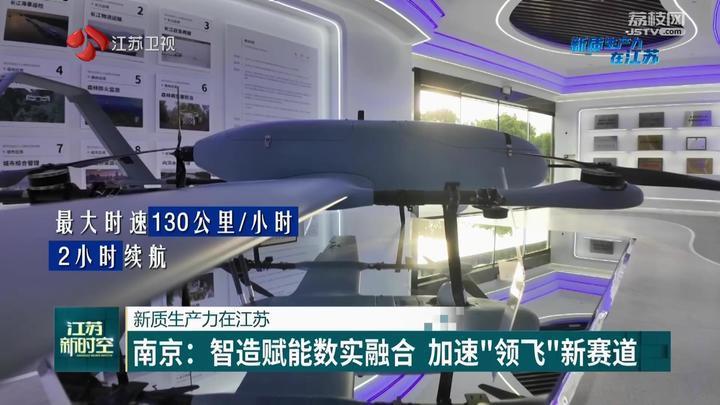Nanjing promotes integration of digital, physical technologies in intelligent manufacturing
The city of Nanjing in east China's Jiangsu province has made every effort to promote the integration of digital and physical technologies in intelligent manufacturing so as to boost the development of new quality productive forces. Let's take a close look.
The low altitude economy has been included in the government work report for the first time this year, and this trillion yuan level new industry has become a field that various regions are competing to explore. Drones are a key element in developing low altitude economy.

In the Nanjing Civil Unmanned Aerial Test Zone, a dazzling array of various types of drones have opened the eyes of visitors. A fixed wing electric drone named Flying Dove can reach a maximum speed of 130 kilometers per hour and has a 2-hour endurance time, making it the endurance champion among similar drones by being able to handle detection and rescue in complex terrains.
A Hongyan 30 low altitude detection drone has broken through multiple international technological barriers by achieving centimeter-level fixed-point takeoff and landing at a high speed of 26 meters per second, or 100 kilometers per hour. Its strong wind resistance allows it to come and go freely in typhoons of 7 or 8 levels.
And all of these are independently developed by the Unmanned Aerial Vehicle Research Institute of Nanjing University of Aeronautics and Astronautics.
The manufacturing of various unmanned aerial vehicles at Nanjing University of Aeronautics and Astronautics has benefited from the sharp perception and advanced layout of the low altitude economic industry in Pukou District of Nanjing.
Since its establishment in 2018, Nanjing Changkong Technology Co., Ltd., the first unmanned aerial vehicle enterprise in Jiangsu, has attracted 40 upstream and downstream enterprises. Pukou District has achieved a series of significant industrial development leaps to become a highland for low altitude economic industry.
“We have invested nearly 200 million yuan in infrastructure construction and various application scenarios, and have carried out various scenarios such as Yangtze River maritime inspection and logistics distribution. We will strive to achieve an annual output value of 1.5 billion yuan by 2025 by carrying out commercial operations, and building a national low altitude economic demonstration zone,”said Yue Lifan, Deputy Director of the Leading Group for the Civil Unmanned Aerial Pilot Zone in Pukou District, Nanjing City.
Nanjing has given full play to its advantages in science and education resources by making every effort to build a low altitude economy as a new engine for the development of new quality productive forces. More than 100 enterprises have gathered in Pukou, Baixia, Qilin, and Linkong Economic Demonstration Zones with the landing of a number of public takeoff and landing points, flight service bases, and 5G communication to promise accelerated growth of the industrial force.
The digital economy is also gaining the same momentum as the low altitude economy. In Nanjing, a city with over 800 thousand software engineers, around 4300 key software related enterprises, and nearly a trillion yuan in software and information service industry scale, a group of influential digital platform enterprises in the country are developing and growing, and China Intellogis Technology Co.,Ltd. is one of them.
A large screen in the control center of China Intellogis Technology Co.,Ltd. displays the real-time distribution of transportation capacity nationwide. The color of the moon represents a denser transportation capacity, indicating higher economic activity.
This economic "barometer" is formed by the integration and support of digital technologies such as big data, artificial intelligence, and blockchain, with over 3 million trucks and cargo ships accumulated on the platform by China Intellogis Technology Co.,Ltd., as well as massive data from over 38000 commercial enterprises.
As a leading platform enterprise that has been deeply involved in logistics big data for over a decade, in recent years,China Intellogis Technology Co.,Ltd. has continuously upgraded its algorithm models, greatly promoting the convenience of goods transportation. Drivers can plan their routes based on the availability of goods to handle an additional four to five orders per month. The shipper can intelligently match the transportation plan with just a few clicks, and the price and transportation time are clear at a glance.

“We have taken advantage of the intelligent networking and routing capabilities of AI to support transportation solutions for highways, railways, waterways, and airlines. According to our big data algorithm, we provide customers with multiple transportation options based on different dimensions such as timeliness, price, and mileage. By reducing costs throughout the entire chain, we help customers achieve quality and efficiency improvement,”said Liu Yunfei, Dean of the Strategic Research Institute of China Intellogis Technology Co.,Ltd.